A 33-Point eCommerce SEO Checklist That Actually Matters!

What’s Inside
- 4 Questions to Answer Before Moving Forward
- On-Page SEO Checklist for eCommerce
- Off-Page SEO Checklist for eCommerce
- Want to learn how to optimize your storefront for maximum conversions?
- Technical eCommerce SEO Checklist
- Content Strategy Checklist
- Impressed with Experro’s SEO capabilities?
- Miscellaneous Checklist for eCommerce SEO
- BONUS: Which eCommerce Platform Has the Best SEO?

- Ready to skyrocket your eCommerce business?
- To Conclude
key takeaways
- Focus on finding target keywords and long tail keywords that align with user intent for your product category pages. This is crucial part of eCommerce SEO checklist.
- Essential elements like title tag and internal linking must be optimized with keywords to improve visibility and relevance on search engines in SEO checklist for eCommerce sites.
- Implementing technical enhancements such as fast page speed, mobile optimization, and secure browsing (HTTPS) significantly impacts your site's search engine performance. These actions are vital parts of the eCommerce website SEO checklist.
- Streamlined site navigation and ease of use, combined with clear CTAs greatly benefit the eCommerce SEO audit checklist.
- Develop and adjust content based on customer feedback, ensuring it meets the needs and interests of your audience as per the guidance from the paid/free eCommerce SEO checklist.
- Engage in link building and social media activity to boost your site's authority and online presence as per the eCommerce SEO management activities checklist.
- Regularly monitor your site's performance through SEO tools and analytics to understand user behavior and optimize according to the ultimate SEO checklist.
With n number of eCommerce startups and enterprise giants in the market, mastering eCommerce SEO is crucial for businesses aiming to secure their space in this digital marketplace.
To your rescue is this eCommerce SEO checklist that will help you as your roadmap to optimize your eCommerce website.
From on page SEO essentials for eCommerce web pages to advanced eCommerce SEO management activities checklist, we cover all bases to drive organic traffic, enhance search engine rankings.
Dive into this comprehensive guide, designed to elevate your eCommerce site through effective SEO efforts.
4 Questions to Answer Before Moving Forward
Here are a few questions you should ask yourself for your website or e-store:
1. Can Search engines (Google) find your site?
Ensuring that Google Search Console and other search engines can discover your site is the foundation of eCommerce SEO. By submitting your sitemap and ensuring your robots.txt file is accurately guiding search engine crawlers, you lay the groundwork for successful indexing and visibility. This is a crucial step in the eCommerce SEO checklist.
2. Can Google crawl your site?
A site's ability to crawl efficiently by search engine crawlers hinges on its site structure and internal linking strategy. An eCommerce website optimized for navigation encourages thorough crawling, helping search engines understand the layout and content of your eCommerce site, emphasizing the importance of an SEO checklist for eCommerce sites.
3. Can Google index your site?
Indexation is crucial for appearing in search engine results. Utilizing meta descriptions, structured data, and ensuring duplicate content is minimized aids search engines in understanding and indexing your eCommerce website pages effectively. This is a part of the eCommerce website SEO checklist.
4. Can Google rank your site?
Ranking in search engine results is the ultimate goal of eCommerce SEO. By focusing on relevant keywords, ensuring a stellar user experience (especially on the mobile version), and building quality backlinks, your eCommerce site stands a better chance at achieving top search engine rankings. This ambition is at the heart of the eCommerce SEO audit checklist.
On-Page SEO Checklist for eCommerce
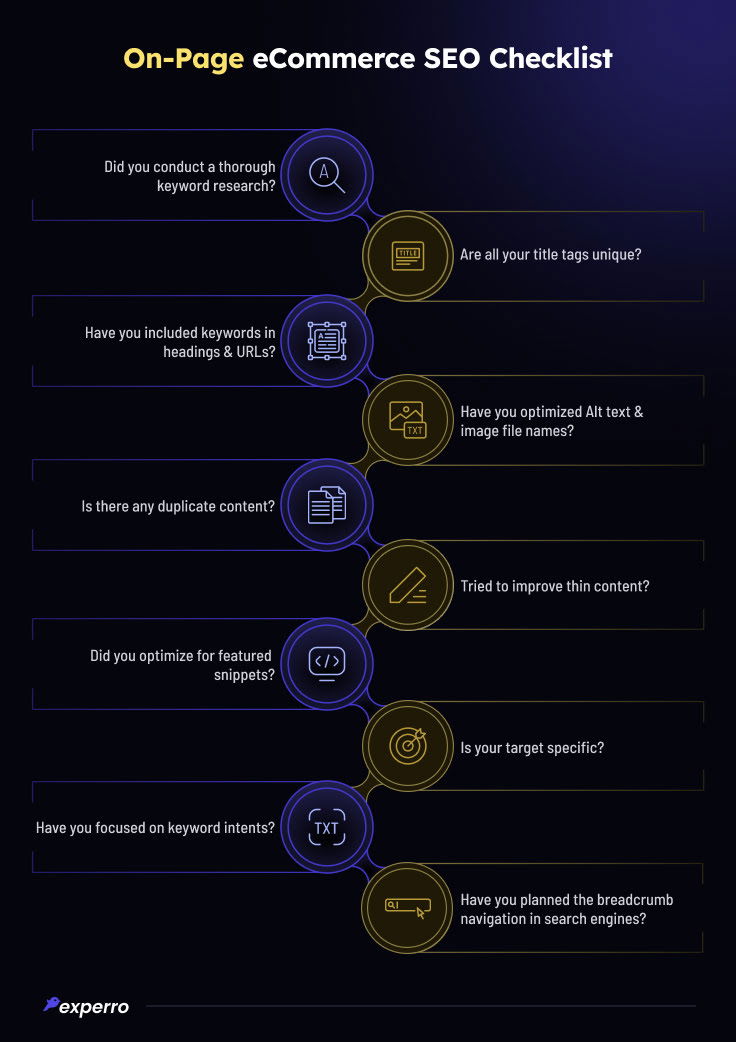
Optimizing your eCommerce website for search engines requires attention to various elements that contribute to your site's search engine rankings and user experience.
This section of our eCommerce SEO checklist focuses on on-page factors that are crucial for enhancing your eCommerce site's visibility in search results.
The following on page SEO checklist for eCommerce website serves as a foundational guide to ensure your eCommerce store is optimized to meet both search engines' and users' expectations.
1. Did You Conduct a Thorough Keyword Research?
The cornerstone of any SEO strategy, including for eCommerce sites, is thorough target keyword research.
Identify relevant keywords and target keywords with high search volume but moderate competition that your potential customers use to find products or information online, a key part of the SEO checklist for eCommerce website.
2. Are All Your Title Tags Unique?
Each title should be unique. Incorporate the primary keyword to improve search engine rankings.
Title tags are critical as they directly impact click-through rates from the search engine results page, an important aspect of the on-page eCommerce SEO checklist.
3. Have You Included Keywords in Headings & URLs?
Incorporating target keywords in headings (such as H1 tags) and in the page URL enhances relevance.
Furthermore, it also helps both search engines and users understand the page content's focus.
This aligns with eCommerce SEO strategies from the website SEO checklist.
4. Have You Optimized Alt Text & Image File Names?
Did you know that 32.9% of queries on Google display images in search results.
For image SEO, ensure all images have descriptive, keyword-rich alt text and file names.
This not only improves accessibility but also helps inform search engines about the context of the images, an essential step in the SEO eCommerce checklist.
Beyond alt text and file names, ensuring images are compressed and properly formatted can further improve page speed and user experience, both of which are important components of the eCommerce website SEO checklist.
5. Is There Any Duplicate Content?
Duplicate content can lead to lower search engine rankings. Ensure each page offers unique content to avoid penalties from search engines, a critical caution in the eCommerce SEO audit checklist.
6. Tried to Improve Thin Content?
Enhance pages with little content by adding informative, valuable content that addresses search intent.
Quality, in-depth content can improve search engine rankings and user engagement, as recommended by the eCommerce SEO management activities checklist.
7. Did You Optimize for Featured Snippets?
Structure your content in a way that it could be selected for featured snippets in search results.
Answering questions directly and using bullet points or numbered lists can increase your chances. It’s a secret tactic highlighted in the ultimate SEO checklist.
8. Is Your Target Specific?
There are four main categories of keywords that you can target on your website:
- Informational - User is looking for details regarding the search query.
- Navigational - User is looking for a particular page/product.
- Commercial - User is surfing for a particular purpose, like checking out the brand.
- Transactional - User is surfing/comparing the price with the intent of purchasing.
Choose your targets with utmost care and attention.
9. Have you Focused on Keyword Intents?
Understanding the intent behind search queries—whether informational, navigational, or transactional—can guide your content strategy to meet users' needs at different stages of their journey, an insight from the eCommerce SEO checklist.
10. Have You Planned the Breadcrumb Navigation in Search Engines?
Search engines favor a robust site structure. And implementing breadcrumb navigation helps users navigate your site more effectively. It’s a prominent strategy within the SEO checklist for eCommerce sites.
Off-Page SEO Checklist for eCommerce
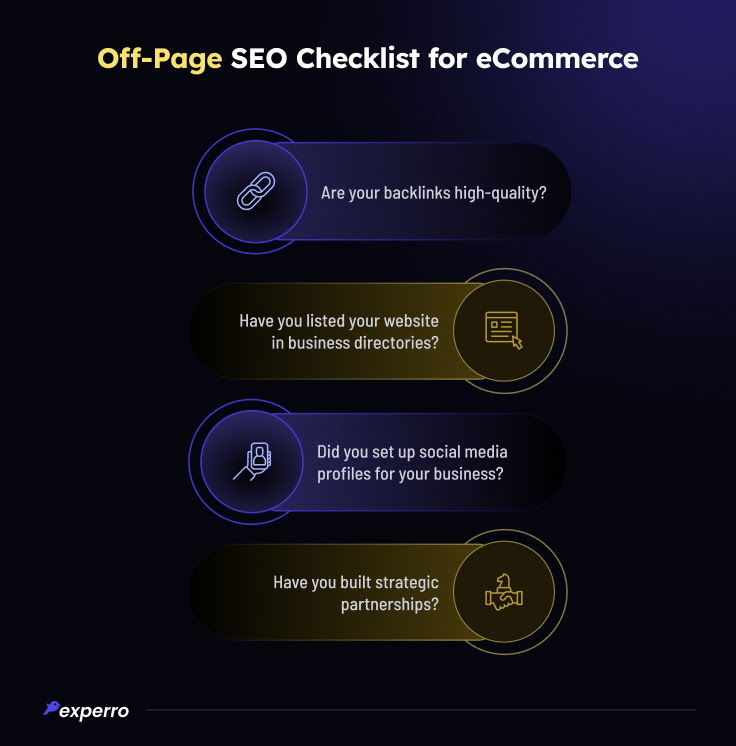
The landscape of eCommerce SEO extends far beyond the confines of your own website.
Off-page SEO tactics are pivotal for establishing your eCommerce site's authority and visibility online.
This segment of our eCommerce SEO checklist highlights essential strategies for enhancing your site's presence through external means.
11. Are Your Backlinks High-Quality?
The reputed backlinks signal to search engines that other eCommerce websites and authoritative domains trust your content, which can significantly boost your search engine rankings.
Focus on creating valuable, shareable content that naturally attracts links, and consider guest blogging on relevant sites to gain high-quality backlinks, as advised by the eCommerce SEO audit checklist.
12. Have You Listed Your Website in Business Directories?
Ensure your eCommerce site is listed in relevant online business directories. This not only helps in driving organic traffic but also strengthens your site's visibility on search engines.
Prioritize directories that are specific to your industry, as well as well-known directories like Google My Business, Yelp, and the Better Business Bureau, aligning with strategies from the SEO checklist for eCommerce sites.
13. Did You Set Up Social Media Profiles for Your Business?
Social media might not directly influence search engine rankings, but the visibility and traffic these platforms can generate is invaluable!
Active social media profiles can drive organic traffic to your site and improve your brand's online presence.
Regularly engaging with your audience and sharing content related to your eCommerce store can indirectly boost your SEO efforts. This is a common but critical tactic included in the SEO eCommerce checklist.
14. Have You Built Strategic Partnerships?
Collaborating with complementary businesses, influencers, and industry bloggers can open up new avenues for link building and audience expansion.
These partnerships can lead to co-marketing efforts, guest blogging opportunities, and shared social media promotions, all of which can enhance your eCommerce site's off-page SEO. It is also suggested in the eCommerce SEO management activities checklist.
Implementing these off-page SEO strategies can significantly impact your eCommerce website's authority and search engine rankings.
By focusing on building quality backlinks, establishing a strong online presence, and fostering strategic partnerships, you position your eCommerce site for greater visibility and success in the search results, echoing the principles of the ultimate SEO checklist.
Technical eCommerce SEO Checklist
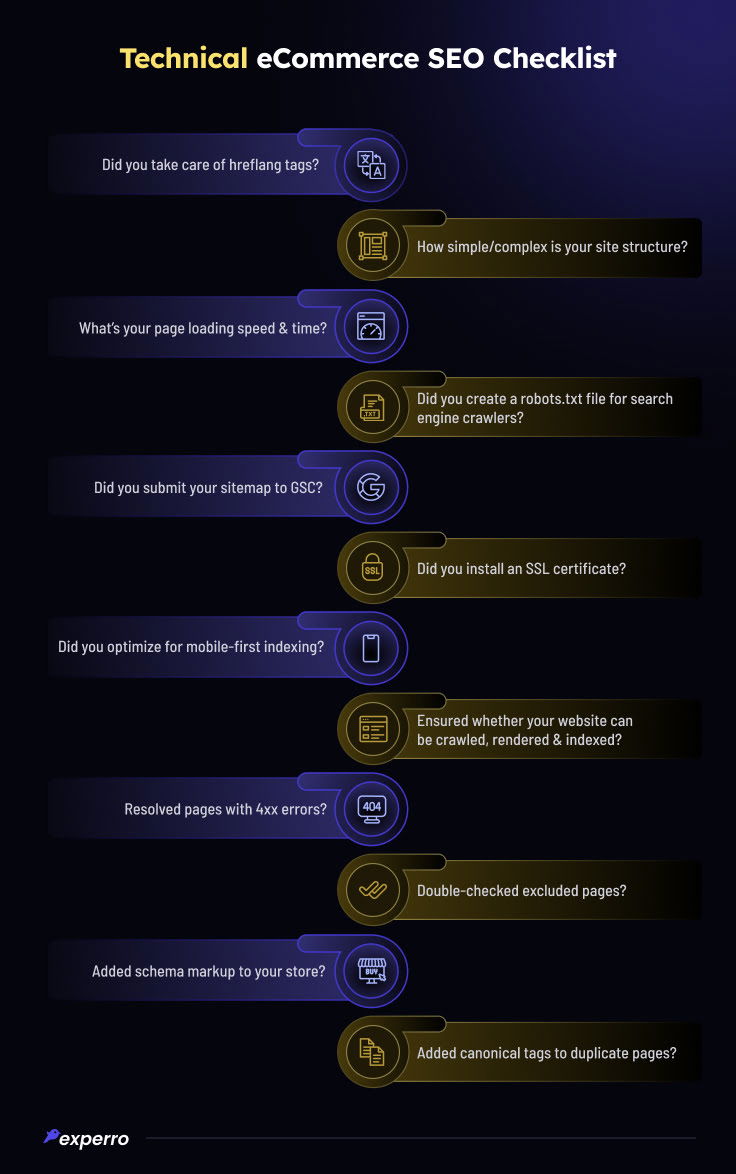
15. Did You Take Care of Hreflang Tags?
Implementing hreflang tags is crucial for eCommerce websites operating in multiple languages or regions.
These tags help search engines understand which version of a page to show based on the user's location or language preference, improving user experience and search engine optimization.
This action aligns with the strategies outlined in the eCommerce SEO checklist.
16. How Simple/Complex Is Your Site Structure?
Site structure is a foundational component of any paid or free eCommerce SEO checklist.
Ensure your site structure and internal linking are optimized to guide visitors to their desired content or products quickly and efficiently.
17. What’s Your Page Loading Speed & Time?
A fast-loading website is essential for both SEO and user satisfaction. In fact, this is most important since you have product pages on your website.
Page speed influences search engine rankings directly and impacts bounce rates.
Use tools like Google's PageSpeed Insights to identify and address any issues slowing down your site, a critical aspect of the eCommerce website SEO checklist.
Let’s reiterate the importance of page speed echoing the principles of the on-page SEO checklist for eCommerce websites:
- image compression
- code minification
- leveraging browser caching can significantly improve your search engine rankings.
18. Did You Create a Robots.txt File for Search Engine Crawlers?
A well-configured robots.txt file guides search engine crawlers on how to interact with your website.
It's essential for preventing the indexing of specific parts of your site that you don't want to appear in search results. This can include admin pages, aligning with advice from the eCommerce SEO audit checklist.
19. Did You Submit Your Sitemap to GSC?
Submitting your sitemap to Google Search Console and Bing Webmaster Tools ensures that search engines can easily find and index your site's content.
This step is primary for search engines to understand your site's structure, a key part of the SEO checklist for eCommerce sites.
20. Did You Install an SSL Certificate?
SSL certificates encrypt data between the user's browser and your website, securing user information.
Having HTTPS instead of HTTP can positively affect your search engine rankings, as search engines prefer secure websites, an important recommendation in the paid/free eCommerce SEO checklists.
It's a clear signal of trust and security to both users and search engines, reinforcing the guidance of the eCommerce website SEO checklist.
21. Did You Optimize for Mobile-First Indexing?
With mobile-first indexing, Google predominantly uses the mobile version of the content for indexing and ranking.
Ensuring your eCommerce site is mobile-friendly is non-negotiable in today's search landscape, a core tenet of the eCommerce SEO management activities checklist.
22. Ensured Whether Your Website Can Be Crawled, Rendered & Indexed?
Beyond creating a robots.txt file, ensure your website is accessible and easily navigable by search engine bots.
Regularly check for crawl errors in Google Search Console and address them promptly, as advised by the ultimate SEO checklist.
23. Resolved Pages with 4XX Errors?
Regularly monitor your site for 4XX errors, such as 404 (Page Not Found) errors, and either fix the broken links.
You may also implement 301 redirects to relevant pages to improve the user experience and SEO performance, aligning with strategies from the SEO checklist for eCommerce store.
24. Double-Checked Excluded Pages?
Use Google Search Console to review any pages you've intentionally excluded from indexing.
Make sure you're not accidentally blocking pages that should be discoverable by search engines, an important step in the eCommerce SEO checklist.
25. Added Schema Markup to Your Store?
Schema markup enhances your search engine results with rich snippets, which can improve click-through rates.
Implementing schema for products, reviews, and business information is particularly beneficial for eCommerce sites, as recommended in the SEO checklist for eCommerce.
26. Added Canonical Tags to Duplicate Pages?
To prevent duplicate content issues, use canonical tags to indicate the preferred version of a page to search engines.
This is especially important for eCommerce websites with products that appear in multiple categories, a critical aspect of the eCommerce SEO audit checklist.
This technical SEO checklist is designed to ensure your eCommerce site is fully optimized for search engines, enhancing visibility, search engine rankings, and ultimately driving more organic traffic to your store.
Content Strategy Checklist
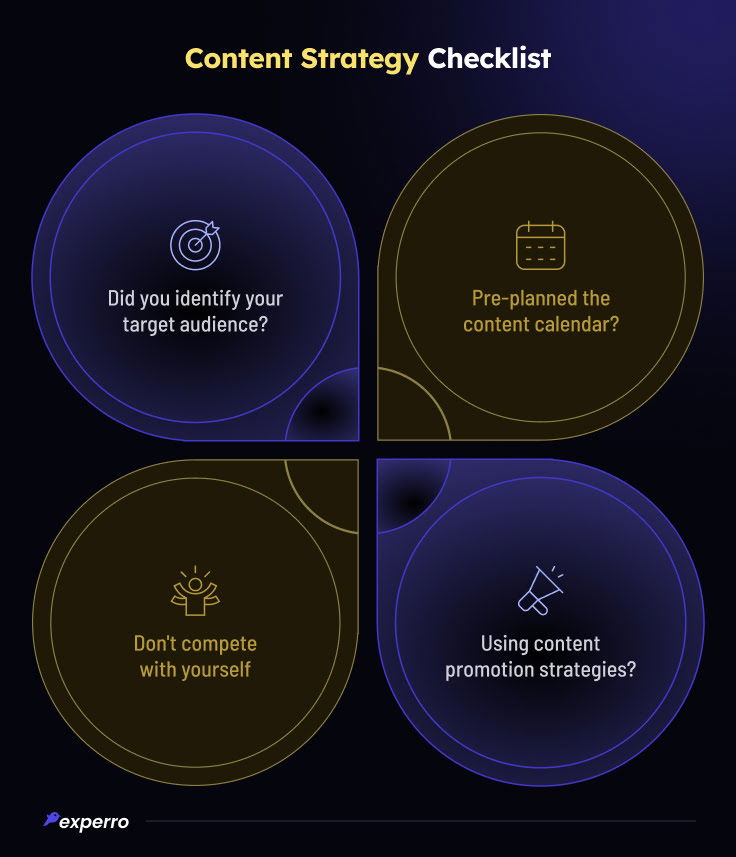
27. Did You Identify Your Target Audience?
This is a vital component of the eCommerce SEO checklist, helping to tailor your content strategy effectively.
Dive into demographic data, customer surveys, and search intent analysis to pinpoint exactly who your content should speak to.
This clarity ensures that the content you produce resonates with your potential customers, addressing their needs, questions, and pain points.
28. Pre-planned the Content Calendar?
A well-organized content calendar is pivotal for maintaining a consistent and strategic approach to publishing on your eCommerce website.
Plan your topics, publication dates, and content formats in advance to align with key industry events, seasonal trends, and your overall marketing objectives.
This foresight is an essential part of the SEO checklist for eCommerce website, aiding in effectively managing resources and ensuring a steady stream of organic traffic.
29. Using Content Promotion Strategies?
Creating great content is just the beginning.
Leverage social media profiles, email newsletters, influencer collaborations, and paid advertising to get your content in front of more eyes.
Tailoring your promotion strategy to the platforms where your target audience spends their time is recommended by the eCommerce website SEO checklist, enhancing the visibility and engagement of your content.
30. Don't Compete with Yourself
When crafting content for multiple products or categories within your eCommerce store, avoid creating multiple pieces of content that target the same keywords or search queries.
This can lead to keyword cannibalization, where your pages compete in search engine results, potentially diluting your SEO efforts.
Instead, focus on creating unique, complementary content for different aspects of your business to cover a broader range of target keywords and search intents.
This strategy is crucial as per the SEO eCommerce checklist, ensuring your site's content is diverse and effective.
By understanding your audience, planning your content calendar, employing strategic promotion, and avoiding internal competition, you lay the groundwork for a successful content marketing campaign that supports your eCommerce SEO strategy, as outlined in the ultimate SEO checklist.
Miscellaneous Checklist for eCommerce SEO
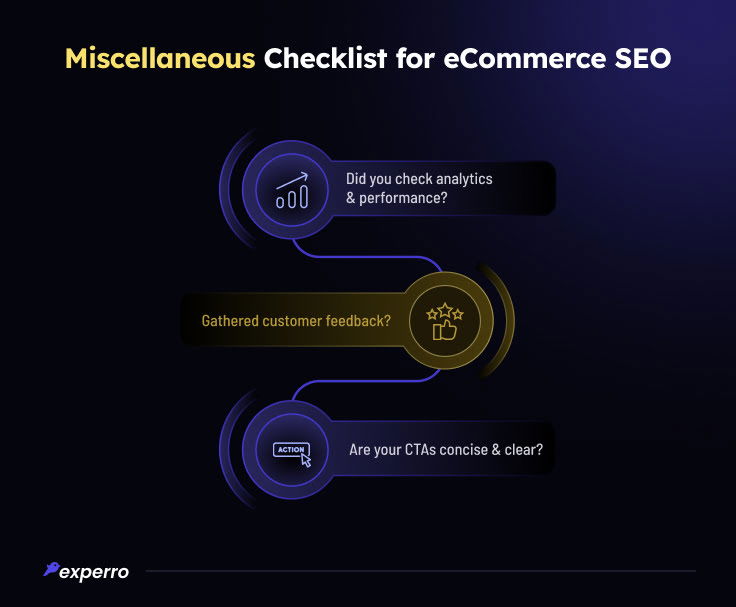
We have handpicked a few integral pointers which categorize under miscellaneous section. Here you go:
31. Did You Check Analytics and Performance?
Incorporating analytics and performance measurement tools like Google Analytics and Google Search Console into your eCommerce SEO strategy is essential for tracking your site's performance and understanding user behavior.
These tools offer insights into organic traffic, page speed, user engagement metrics, and conversion rates. These enable you to make data-driven decisions to optimize your eCommerce website further.
The eCommerce analytics approach is a fundamental aspect of the eCommerce SEO management activities checklist.
32. Gathered Customer Feedback?
Actively seeking and incorporating customer feedback is vital for continuously refining your eCommerce site's content and overall user experience.
Utilize surveys, feedback forms, and social media interactions to gather insights.
Adjust your content strategy based on this feedback to better meet your audience's needs and preferences, potentially boosting search engine rankings and customer satisfaction. This process is crucial in the free eCommerce SEO checklist.
33. Are Your CTAs Concise & Clear? (Calls to Action)
Clear CTAs guide users towards taking the desired actions on your eCommerce site, whether it's making a purchase, signing up for a newsletter, or contacting customer support.
Ensure your CTAs are prominently placed, compelling, and clearly state the benefit to the user as outlined in the eCommerce SEO checklist.
By focusing on these additional aspects—analytics, customer feedback, site navigation, ease of use, page speed, mobile optimization, and clear CTAs—you can further refine your eCommerce website to meet user expectations and improve your search engine rankings.
BONUS: Which eCommerce Platform Has the Best SEO?
Experro, by far, offers the most flexible, scalable, and secure platform for multiple industries.
Talking specifically about the eCommerce domain, the platform offers an amazing all-in-one eCommerce storefront to build and launch a website. It’s the best-in-breed platform to kickstart your business.
To Conclude
In summary, effective eCommerce SEO requires meticulous attention to both on-page and off-page optimization, technical adjustments, and content strategy.
The provided eCommerce SEO checklist outlines essential steps for businesses to enhance online visibility and user experience, driving growth. Regular updates, adherence to search engine guidelines, and responsive adjustments to user feedback are key to maintaining and improving your site's performance.
To learn more, schedule a call with our experts.
FAQs


Ekta Ganwani
11 July 2024With a sharp knowledge of SEO and SERP, Ekta's research is her strength. She is a meticulous researcher with an eagle eye for finding errors and ensuring on-page content is top-notch. When not working, Ekta can be found binging the latest Netflix series or meditating to find her inner zen.